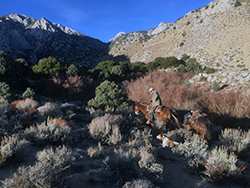
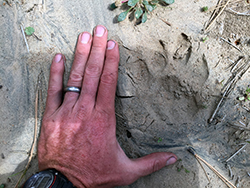
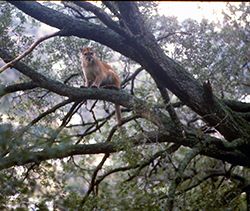
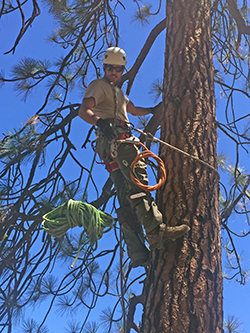
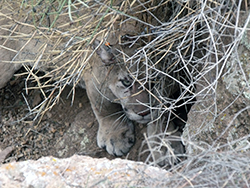
It’s just before dawn in the eastern Sierra Nevada Mountains in Mono County. It’s a cold clear morning, a good day to be out experiencing a still very much wild area of California. California Department of Fish and Wildlife (CDFW) biologist Justin Dellinger and a Wildlife Services houndsman are preparing gear to go out looking for fresh mountain lion tracks in this vast landscape. With the help of a team of highly trained dogs, Dellinger and the tracker are focused on the ultimate goal: Capturing a mountain lion and outfitting it with a GPS collar for research purposes.
This tracking effort in Mono County is part of a larger project to estimate mountain lion population size statewide. It began in the southern Cascades and northern Sierra-Nevada Mountains in 2015, and since then CDFW has solely undertaken or collaborated on similar efforts in the north coast, Modoc plateau and here in the eastern Sierra Nevada Mountains. It’s tough work with long hours; trackers can spend days or even weeks in pursuit of lions. Yet tracking remains the gold standard method of gathering data in the mountain lion research world.
Notably, it takes both biologist and houndsman, each with a unique skill set, to make this team effort work. On this particular day, for example, Dellinger starts the ball rolling when he spots a fresh set of mountain lion tracks made the night before. The mark of the hind heelpad, measuring 52mm across, indicates that it’s a tom (male cat) heading southwest. The long stride suggests he’s traveling in a focused and determined manner – perhaps to secure a meal, locate a mate or confront another male trying to move in on his turf.
Dellinger radios the houndsman, who is astride a mule. The houndsman makes his way to the tracks with dogs in tow, where he assesses a wide variety of information – the time of day, wind speed and direction, topography, etc.
“The mental calculations (of the tracker) are rooted in decades of experience and know-how, but they’re still somewhat of an enigma to me,” Dellinger says. “But then again, houndsman feel likewise about the statistical calculations employed by biologists. It takes both of us, working together, to compile all the information and derive a solid population estimate.”
Over the next several days, the houndsman and the biologist follow the tom over miles of country, with the cat none the wiser about his pursuers. The team eventually catches up to the tom. The dogs masterfully trail him over boulders and around escarpments and tree him in a pinyon pine. The houndsman signals to Dellinger that the tom is treed. Dellinger then works his way into position to dart the animal. Success! Within an hour, the cat is asleep and Dellinger is able to affix a collar.
Yet despite the enormity of the overall effort, the day’s accomplishment is only one small step in the overall plan. Simply put, they’ll get a little rest and then wake up and try to do it all over again tomorrow.
As CDFW’s lead mountain lion biologist, Dellinger understands the need to study and understand Puma concolor only too well. “Lions are the apex predators across much of California, and apex predators can tell scientists a lot about the ecological wellbeing of a given landscape or ecosystem,” he explains. “If mountain lions are decreasing in an area, it’s likely that prey species are decreasing too. If mountain lions are exhibiting health issues, it’s likely that other animals in the ecosystem are experiencing similar issues.”
Because of those grants, this first comprehensive effort to collar lions around the state is now underway. It’s a huge and somewhat daunting task. California’s size and ecological diversity requires a divide-and-conquer approach, meaning that studies can only be conducted in one area at a time. Together, those “slices” of data will add up to a statewide picture.
Getting the collar on the cat might be the most important part, but all of the data Dellinger collects on this trip will be useful. He’ll be able to compare tracks and remote game camera photos with GPS collar data to derive a minimum count of mountain lions in the area. For now, this is the best way of counting mountain lions in the western United States. In the future, CDFW may grow to rely on data gathering techniques that are more cost- and time-effective than tracking, and use more common skill sets. One possible alternative is developing thanks to the rapid advance of using genetics to monitor wildlife species without having to handle the animals. Scat samples can be collected and analyzed to provide a genetic fingerprint of the animal that deposited them. In theory, if enough lion scat is collected over a large enough area, CDFW can estimate the number of lions in the area.
But scat analysis is still a fairly new way of doing things, and until techniques can be tested, compared and perfected, CDFW will continue to employ the tracking “gold-standard.” The newer methods can be compared to the old, and it’s possible that the newer methods will outperform (i.e., be cheaper and just as reliable) the older methods in some areas but not other areas.
CDFW sees this statewide effort as a first step in monitoring and conserving the elusive, ecologically important mountain lion long-term in California. The project is still in its early stages and will likely continue for another six years or so. Dellinger is enthusiastically looking forward to the work. “It’s really cool because no other state has attempted such a comprehensive population assessment of lions … and no other western state is as ecologically diverse as California,” he says. “Doing something this comprehensive requires working in a lot of very unique areas. It’s never going to be boring.”
Photos courtesy of Justin Dellinger